Project and Water News
Python strikes at USU Code Camp
When asked why he’s spending a day of his summer vacation at the CI-WATER/Utah State University (USU) Code Camp, Colton grins and says, “I just want to out-code my friend. We try to crash each other’s computers.”
For Joseph, an interest in coding is a family matter: his dad, a computer programmer, introduced him to the subject. After building a website with html and taking an online course to create computer games with Flash, Joseph was hooked.
CI-WATER researchers Jeff Horsburgh and David Rosenberg, the facilitators of the June 11 camp, find coding pretty fun too. They also find it essential to their work on hydrological modeling. They’re giving the sixteen high school students in the camp a glimpse of where coding meets water with a series of activities on the USU campus.
The day began with a tour of USU’s High Performance Computing and Data Centers followed by an interactive workshop in the USU Engineering Computer Lab, where participants learned the basics of coding with Python. The computer language, which was new to most of the participants, was chosen for because it can run on multiple platforms, is relatively easy to learn and generates results more quickly than some languages—all features that are helpful for a one-day event.
Now that lunch on the lawn is over, teams of participants are applying their new Python skills to determine how much water should be released from a reservoir based on historical data. The room buzzes as students exchange ideas, collaborate over their keyboards and laugh at their outrageous results and ingenious solutions. In a few minutes, they’ll present their work, competing for prizes in three categories: Release Code for Most Revenue, Most Concise Release Rule That Actually Runs and Generates Reasonable Benefits and Best Documentation of the Code.
But as far as the professionals running their camp, they’ve all won already.
“They’ve hit on major reservoir operations concepts,” says Dave. One team has even discovered a method for reducing flood risk that water managers actually use.
“This is exciting,” Jeff adds, looking around the USU Engineering Computer Lab. “I’m really pleased with the level of engagement from the students.”
As if on cue, one participant turns to look at Jeff and says, “Next time, this has to be a week-long camp!”
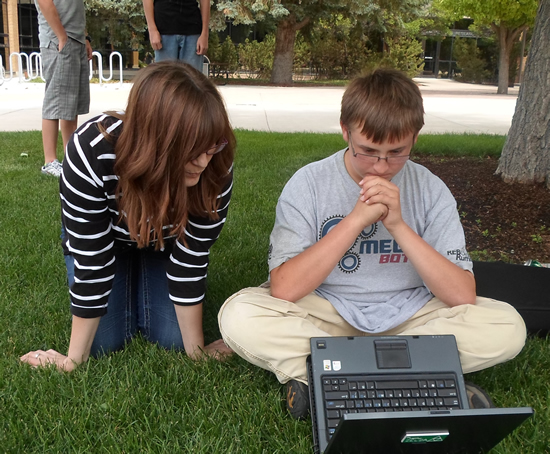
CI-WATER research assistant helps camper debug code.

Teams collaborating on code challenge at USU.
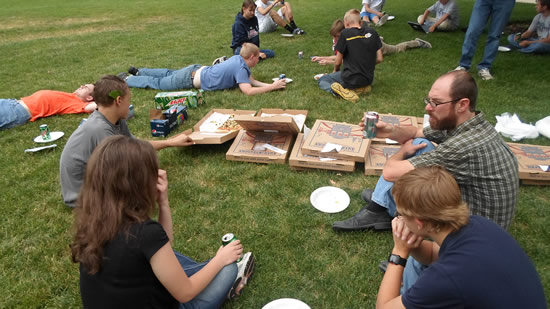
CI-WATER researcher David Rosenberg enjoying lunch with the campers.

CI-WATER researchers taking a quick break.
July 10, 2013
Utahns invited to speak up about water at series of public meetings
How should Utah look in 10, 20 and 50 years? Utah Governor Gary Herbert invites Utahns to share their ideas with water resource experts at one of the public meetings listed below. Those who cannot attend the meeting may share their thoughts online at http://www.utahswater.org/.
Topics to be discussed include—
- Managing water to maximize efficiency
- Addressing competition for water resources
- Supplying water for a growing population while protecting the environment and high quality of life
- Funding construction and maintenance of water infrastructure
- Supplying water for agriculture
- Addressing the complexities of water law
- Considering other issues relating to Utah’s long-range water future
Meeting Schedule
All meetings will be held from 7 p.m. to 9 p.m. with a public comment period followed by breakout sessions.
|
July 9 |
Richfield |
Sevier County Fairgrounds, 410 East 200 South |
|
July 11 |
Layton |
Layton City Council Chambers, 437 North Wasatch Drive |
|
July 16 |
Price |
Price City Hall, Room 207, 185 East Main Street |
|
July 18 |
Provo |
Provo High School, Auditorium, 1125 N University Ave |
|
July 25 |
St. George |
Dixie State University, 225 South 700 East |
|
Aug 6 |
Vernal |
Vernal City Council Chambers, 374 East Main Street |
|
Aug 13 |
Salt Lake |
Department of Natural Resources, 1594 W North Temple |
|
Aug 15 |
Logan |
Mount Logan Middle School, 875 North 200 East |
More Information...
July 9, 2013
A time for learning and exploring: The Summer Institute for Teachers
“Did you just give us the five minute warning?”
Molly Malone nods, much to the disappointment of the teachers gathered around the Hydropoly board. Their game of water management and sustainability was just getting started.
For almost an hour, teachers from Utah and Wyoming have been exploring a CI-WATER Teaching Toolbox. The toolbox contains Hydropoly (a water resource game based on Monopoly), microscopes, numerous books, vials of hydrophobic sand, a water model, water testing kits and more.
Investigating the toolbox was just one of the activities the eleven 7th-12th grade science teachers participated in over the course of the CI-WATER Water Resources Modeling Summer Institute. Beginning 24, the week-long institute aimed to increase understanding of water issues in the west, expose teachers to resources for teaching water science and develop curriculum centered on CI-WATER concepts.
The week began with talks by CI-WATER researchers about their work and areas of expertise.
“I learned so many new things about using models,” says Bonnie Bourgeous, who teaches 9th grade at North Layton Jr. High in Utah. “I teach both science and math, and have many students for both subjects. It is great when you can make clear connections between content areas and involve students in real world projects. The use of models in predicting future events was especially informative and useful.”
After each session with the CI-WATER researchers, the teachers cultivated key concepts which they then used to develop new curriculum ideas.
“During the last three days of the workshop the teachers collaborated in small groups to develop ideas for curricula that address important concepts for students from the CI Water expert talks,” says the University of Utah’s Molly Malone, the institute coordinator. “The groups generated excellent ides for interactive online and multimedia activities and paper-based lessons that explore the limitations and capabilities of water modeling, the complexity of the water cycle, and uses of models in the decision-making process.”
With their variety of backgrounds, teaching experiences and school locations, the educators developed curricula that can meet the needs of all students, whether in the urban schools of Salt Lake City or in the rural schools on the Wind River Reservation in Wyoming.
“This was a very mindful and creative group who clearly considered what would engage students and best convey important concepts about models and water decision-making in the Intermountain West,” says Molly.
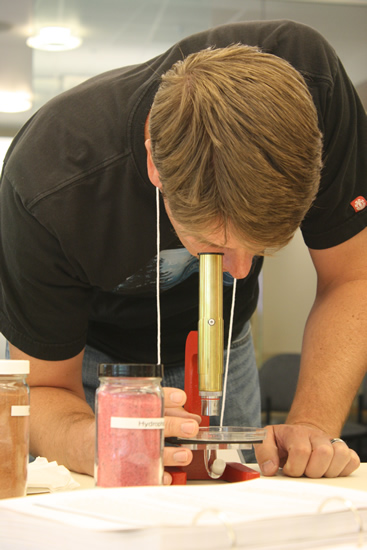
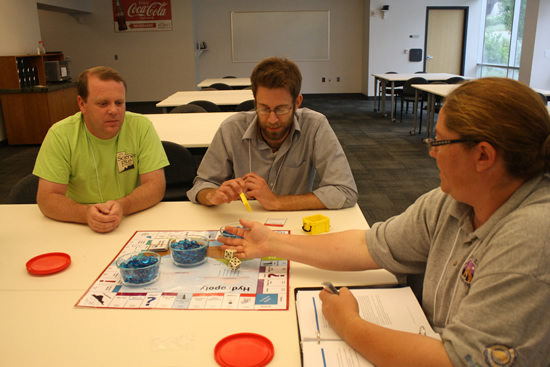
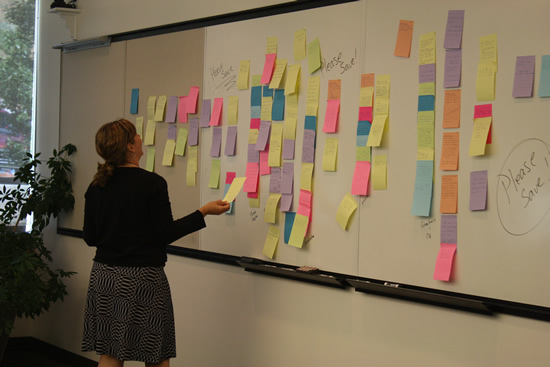
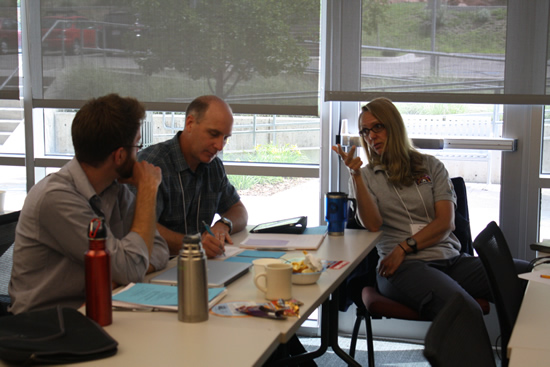
June 28, 2013
Job posting: Research Assistant Professorship in Hydroinformatics at USU
CI-WATER partner Utah State University (USU) and the Utah Water Research Laboratory have announced the opening of a research faculty position in Hydroinformatics. The successful candidate will contribute to the development of cyberinfrastructure for the NSF-EPSCoR funded project innovative Urban Transitions and Aridregion Hydro-sustainability (iUTAH).
An equal opportunity employer, USU is dedicated to recruiting stellar candidates from a diverse pool including women, minorities, veterans and people with disabilities.
More Information...






